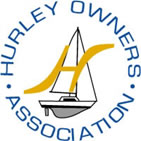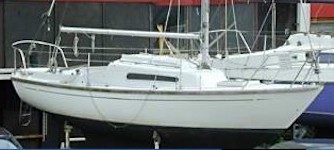


HURLEY 22

The Hurley 22 is a long-established family cruising yacht that is available with fin or bilge keels.Developed in 1964 and first sold in 1966, the Hurley 22 became an instant hit. Quite aside from her pretty lines - she looked like a 'proper yacht' - she is solidly built and is a good performer. From the outset the Hurley 22 was intended to be raced as well as cruised. A H22 even won the Round The Island Race in 1967 and they acquitted themselves well on the JOG circuit. But it has been the H22's cruising performance that has won the respect of many yachtsmen over the years. Hurley owners speak fondly of the little boat's performance and sea-kindliness. The boats have proved themselves on long cruises; several 22s have crossed the Atlantic, and at least one has cruised the Pacific.
In 1963 George Hurley provided designer Ian Anderson with a brief to meet the demands of the family yachtsman, essentially to provide a medium to heavy displacement, safe, seaworthy yacht in both fin- and bilge-keel form, with berths for four and being suitable for either inboard or outboard engine, while at the same time retaining classic lines. The result was the Hurley 22 - classic in its time.The 22 went into Lloyds approved series production in 1966 and was in almost constant production up to 1990 by which time 1203 had been built. The moulds are still available to build new boats but as far as we know none have been built since 1990
The ballast ratio of the fin keel yacht is very impressive at 40% but the bilge-keeled version performs very well with deep twin keels. Most are powered by outboards housed in the lazarette well, some have engine mounts moulded into the transom but around 5 - 8% have inboards fitted, making them very special little boats.
In the late 60s the yacht was very successfully raced and marketed by SHE yachts. The owner Derek Fitzgerald produced theH22S version with slightly taller Proctor rig, different winches and altered central cockpit mainsheet traveller and raced her under JOG rules. The Hurley 22 has been very successful in club racing over the years
By 1969 production was running at three yachts per week and Hurley developed an excellent sales network throughout Europe and America. The yacht proved very popular in Holland, Denmark and Sweden. In 1972, having produced 731 boats the last 22 was built by Hurley Marine in favour of the bigger Hurley designs now coming into production, the H27 in 1971, the H24/70 in 1972 and then the H30/90 in 1973.
Beween 1969 - 1971 the Royal Navy bought more than thirty Hurley 22s and used them for training purposes. They were mainly fin keeled and were given girls names. The Navy insisted that the Hurley 22 was given a skeg. Prior to that they had semi-balanced scimitar rudders that could be rotated through 360 degrees. However, the original rudder configuration was available as an option. The RN sold them off at auction during the nineties.
At the end of 1972, after building 731 H22s, Hurely Marine stopped building them, replacing the H22 with the new H24/70. The moulds were sold sometime towards the end of 1973.
In August 1974 Hurley Marine went out of business having endured two years of a recession and the H22 moulds were bought by two ex-Hurley employees who set up an enterprise called South Coast Marine, another set of moulds were bought by a Dutch company called Holland Yachting who also bought the rights to the Hurley name. There's no proof that any H22s were built in Holland. In 1975 SCM re-started production of the H22 having the hull and deck mouldings produced by Moody Marine Projects. Around 40% of SCM H22s were exported to Holland and sold there as the Hurley 700. SCM subsequently produced new deck moulds incorporating an anchor locker and long window to maintain the high standards set by the original builders and in April 1980 at the beginning of the next recession SCM went into receivership having built about 425 boats. Around 20 of their boats were left in the hands of the receivers and these were sold off unfinished in 1981.
The moulds were sold to John Rattenbury of Ravensail Marine, Okehampton in 1981 and Ravensail finished their first in 1982. Asmaller company, Ravensail produced about 42 up until John sold the company to Hurlwind who moved production to Credition in 1988, Hurlwind built just 5 up to 1990.
After Hurlwind
the moulds were lost for a while but were found again grown-in behind
a large hedge and moved to Blaxton Boats but none where built there.
The moulds are now in the hands of another proposed yacht building
company somewhere on the south coast.
New Woodwork Beading and Capping
An article by Kevin Mitchell about revamping the bulkhead in a SCM H22 |
|
|
Link to Albert Luescher's photo album featuring his H22 "Osiris"(no longer available).
|
|
|
Running the halyards back to the cockpit
An article by Kevin Mitchell about running the halyards back
to the cockpit in a SCM H22 |
|
|
Hurley 22. Omega. Fin v bilge keel.
An article by James Jaffrey about choosing and buying a H22
and his first experiences of sailing her |
Renewing the cockpit sole
An article by Kevin Mitchell about renewing the cockpit sole
in his SCM H22 |
|
Learning by Doing
An article which appeared in the Danish sailing magazine Bådmagasinet
(see www. baadmagasinet.dk).
HOA member Lars Ole Badenholt has just bought the Hurley 22
“Knirke” (means "Squeak") - his first
boat at age 69! |
Servicing
sheet winches.
An
article by Kevin Mitchell about servicing the sheet winches
on his SCM H22 |
|
ARE YOU THINKING OF BUYING A HURLEY 22?
Here's some guidance from Bruce Carter
|
|
| An interesting article from ex-Hurley employee, Colin Curtiss, on building the H22 can be found here |
|